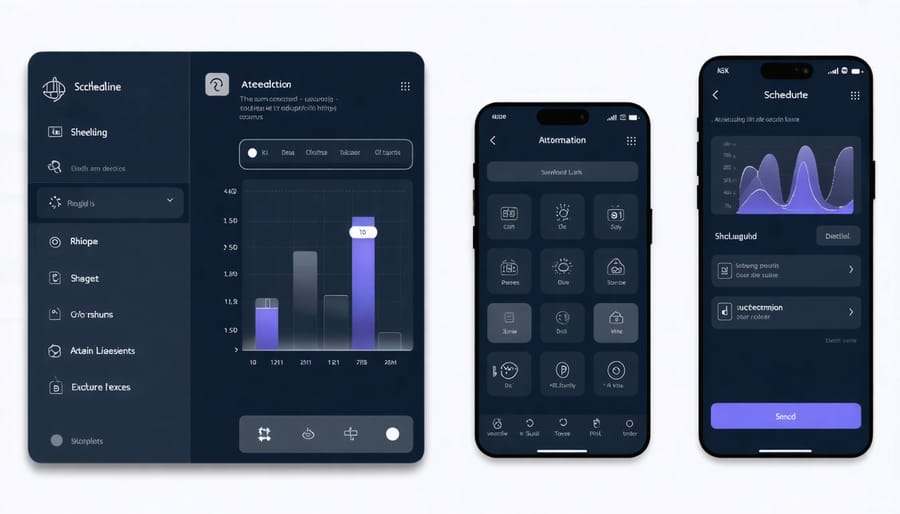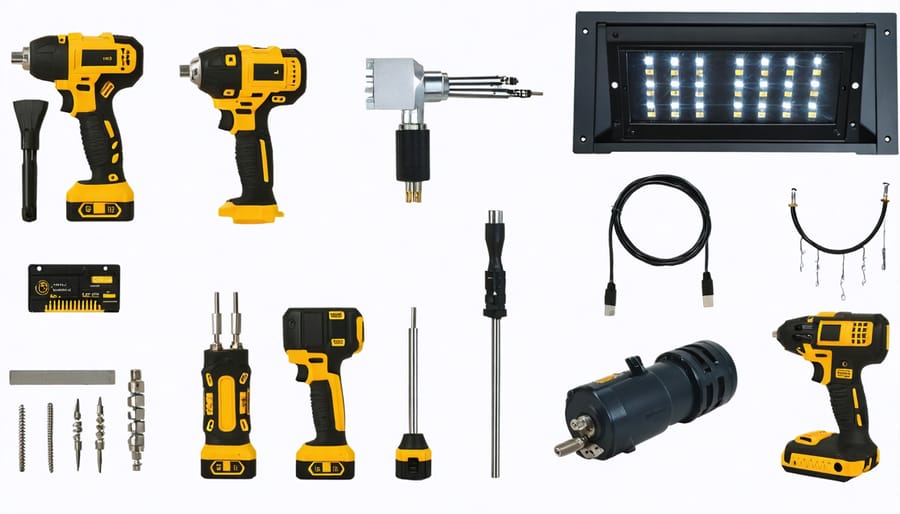Transform your outdoor space into a smart, energy-efficient oasis with permanent LED lighting that you can control from anywhere. Modern outdoor smart lights don’t just enhance your home’s entrance – they revolutionize how you interact with your exterior lighting system while cutting energy costs by up to 80%.
Gone are the days of fumbling with timers or leaving lights on accidentally. Today’s permanent outdoor smart lights integrate seamlessly with your home automation system, offering motion detection, color-changing capabilities, and automated scheduling that adapts to seasonal changes. Whether you’re creating ambiance for outdoor entertaining, boosting security, or highlighting architectural features, these weather-resistant fixtures provide years of maintenance-free illumination while adding significant value to your property.
With options ranging from sleek path lights to sophisticated flood lights, and integration with popular platforms like Alexa and Google Home, permanent outdoor smart lights represent the perfect blend of functionality, aesthetics, and modern convenience. Let’s explore how these innovative lighting solutions can transform your outdoor living space while making your home smarter and more secure.

Why Permanent Smart Outdoor Lights Are Game-Changers
Energy Efficiency and Longevity
Modern LED technology is at the heart of permanent outdoor smart lights, offering an impressive combination of efficiency and durability. These fixtures can reduce energy consumption by up to 80% compared to traditional outdoor lighting, making them an environmentally conscious choice that’s also friendly to your wallet.
Most quality LED smart lights are rated to last between 15,000 to 25,000 hours – that’s about 15-20 years of normal use! This extended lifespan means less frequent replacements and lower maintenance costs over time. Plus, smart features like automated scheduling and dimming capabilities help maximize energy savings by ensuring lights are only on when needed and at the optimal brightness level.
The initial investment in permanent outdoor smart lights might be higher than traditional options, but the long-term benefits are substantial. Between reduced energy bills, minimal maintenance requirements, and the extended lifespan of LED technology, these lighting systems typically pay for themselves within a few years while providing reliable illumination for decades to come.
Weather-Resistant Design
When it comes to outdoor smart lights, weather resistance isn’t just a nice-to-have feature—it’s absolutely essential. Quality permanent outdoor smart lights are built to withstand nature’s toughest elements, from scorching summer heat to freezing winter storms. Most models come with an IP65 or IP67 rating, meaning they’re completely protected against dust and can handle powerful water jets or even brief immersion.
Look for fixtures made from durable materials like powder-coated aluminum or high-grade weather-resistant plastics that won’t rust or corrode. UV-resistant components are also crucial, as they prevent the light housing from becoming brittle or discolored after years of sun exposure.
The best outdoor smart lights feature sealed compartments for their electrical components and rubber gaskets around any openings or connection points. Some manufacturers even include special drainage channels to prevent water accumulation, while others use advanced thermal management systems to protect internal electronics from temperature extremes.
Remember to check the operating temperature range of any lights you’re considering—quality fixtures typically function reliably from -4°F to 122°F (-20°C to 50°C), ensuring year-round performance in most climates.
Smart Features That Make Life Easier
App Control and Voice Commands
One of the most exciting features of permanent outdoor smart lights is the ability to control them right from your smartphone. Most modern systems come with user-friendly apps that let you adjust brightness, set schedules, and even change colors with just a few taps. You can turn your lights on before arriving home or set them to automatically illuminate at sunset.
Voice control adds another layer of convenience to your outdoor lighting setup. Whether you use Amazon Alexa, Google Assistant, or Apple HomeKit, you can simply say commands like “Turn on the patio lights” or “Set backyard lights to 50% brightness.” This hands-free control is particularly helpful when you’re carrying groceries or entertaining guests.
Many smart lighting systems also integrate seamlessly with broader home automation routines. You can create scenarios like “Movie Night” that dim your outdoor lights, or “Welcome Home” that lights up your pathway and entrance. Some systems even work with motion sensors to automatically brighten when someone approaches.
For added security, you can set up random lighting patterns while you’re away, making it appear as if someone’s home. Most apps also allow you to group different zones of lights together and control them separately – perfect for creating distinct ambiance in different outdoor areas.
Pro tip: Look for systems that offer offline control through a hub, ensuring your lights still work even if your internet connection goes down.

Scheduling and Automation
One of the most exciting features of permanent outdoor smart lights is their ability to run on autopilot through intelligent scheduling and automation. Setting up your lighting routines is surprisingly straightforward and can significantly enhance your home’s functionality and curb appeal.
Start by establishing your daily schedule through your smart light’s companion app. Most systems allow you to create multiple schedules for different days of the week. For example, you might want your lights to turn on at sunset and off at midnight during weekdays, but stay on later during weekends for entertaining.
Motion detection can be integrated into your scheduling for added security and convenience. Configure your lights to brighten when movement is detected and dim after a set period of inactivity. This feature is particularly useful for driveways and entry points.
Take advantage of seasonal lighting automation to adjust your lighting patterns throughout the year. Your lights can automatically adapt to changing sunset times and weather conditions, ensuring optimal illumination regardless of the season.
Many systems also offer special event scheduling for holidays or parties. Create custom scenes with different brightness levels and color combinations, then save them for future use. Some advanced systems even allow you to sync your outdoor lights with music or coordinate them with other smart home devices for a truly automated experience.
Remember to periodically review and adjust your schedules to ensure they still match your lifestyle and needs. Most apps also offer vacation modes to simulate occupancy while you’re away.
Installation and Setup
Professional vs. DIY Installation
When it comes to installing permanent outdoor smart lights, you have two main options: professional installation or taking the DIY route. Each approach has its merits, and your choice should depend on your comfort level with electrical work and the complexity of your desired setup.
Professional installation offers peace of mind and expertise, particularly when integrating smart lights with other exterior design features. Certified electricians understand local codes, ensure proper weatherproofing, and can handle complex wiring scenarios. They’ll also guarantee their work and often provide ongoing support. However, professional installation typically adds $200-500 to your project cost.
DIY installation can save money and offers a sense of accomplishment, but it requires careful planning and basic electrical knowledge. If you’re comfortable working with low-voltage systems and following detailed instructions, many smart light systems come with user-friendly installation kits. You’ll need tools like wire strippers, a voltage tester, and weatherproof connectors.
For simple installations along existing power sources, DIY is often feasible. However, if your project requires new wiring runs or complex integration with home automation systems, professional installation is recommended for safety and optimal performance.
Essential Tools and Materials
Before starting your outdoor smart light installation, gather these essential tools and materials to ensure a smooth process. You’ll need a power drill with various drill bits, a wire stripper, and a voltage tester for electrical safety. Don’t forget a sturdy ladder that can safely reach your installation height, and make sure to have a helper spot you while working at elevation.
For mounting and wiring, collect weatherproof wire nuts, electrical tape, and outdoor-rated junction boxes. You’ll also want silicone caulk and weatherproof gaskets to prevent moisture infiltration. A level, measuring tape, and pencil are crucial for marking accurate installation points.
Essential safety equipment includes work gloves, safety glasses, and a dust mask for drilling. Keep a utility knife, screwdrivers (both Phillips and flathead), and adjustable wrenches handy for various adjustments and connections.
For the smart components, prepare your Wi-Fi network information and download the manufacturer’s recommended app before starting. Having a smartphone or tablet nearby during installation will help with setup and testing. Consider keeping some spare mounting hardware and wire just in case – it’s better to have extra than to pause mid-installation for a hardware store run.

Maintenance and Troubleshooting
Regular maintenance of your outdoor smart lights will ensure they continue to shine bright and operate efficiently for years to come. Here’s your guide to keeping your system in top shape and troubleshooting common issues.
Start with a quarterly cleaning routine – gently wipe down light fixtures with a damp cloth to remove dust, cobwebs, and debris. For coastal areas or regions with heavy pollution, you might need to clean monthly to prevent corrosion and maintain brightness.
Check all connections at least twice a year, particularly after severe weather events. Look for loose wires, damaged seals, or signs of water intrusion. Ensure your WiFi signal remains strong by keeping your router in good condition and considering a WiFi extender if needed.
Common issues and their solutions:
– Lights not responding: Check your app connection first, then verify power supply and WiFi stability
– Inconsistent performance: Update your app and firmware regularly
– Dimming issues: Clean any light sensors and check scheduling settings
– Connection drops: Reset the system and reconnect to your network
– Moisture problems: Inspect and replace any damaged seals or gaskets
For optimal performance, trim any vegetation that might block light sensors or WiFi signals. During winter, clear snow and ice build-up promptly to prevent damage. Replace backup batteries in controllers annually, even if they seem fine.
Keep your warranty information and manufacturer’s contact details handy. While most issues are easily resolved, don’t hesitate to contact professional support for electrical problems or persistent connectivity issues – safety should always come first.
Transforming your outdoor space with permanent smart lights is more than just a trend – it’s an investment in your home’s functionality, security, and aesthetic appeal. These innovative lighting solutions offer unparalleled convenience through automated scheduling, weather-responsive controls, and seamless smartphone integration. By choosing permanent outdoor smart lights, you’re not only enhancing your home’s curb appeal but also creating a safer, more energy-efficient environment for your family and guests.
The initial setup might require some planning and investment, but the long-term benefits far outweigh the costs. From reducing your energy bills to providing peace of mind through enhanced security features, smart outdoor lighting proves its worth day after day. Whether you’re hosting backyard gatherings, creating ambient evening atmospheres, or simply wanting to come home to a well-lit property, these systems deliver consistent performance and reliability.
Ready to make the switch? Start with a small area of your outdoor space and gradually expand your smart lighting system as you become more comfortable with the technology. The future of outdoor lighting is here, and it’s brighter than ever.
